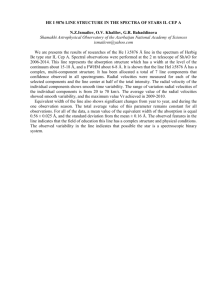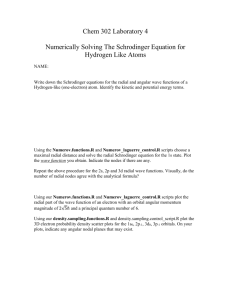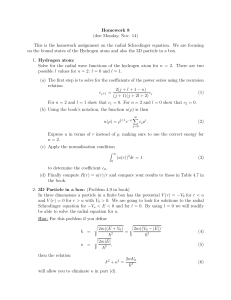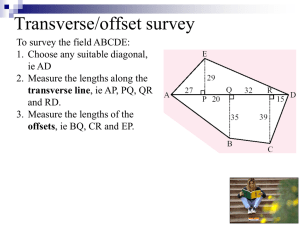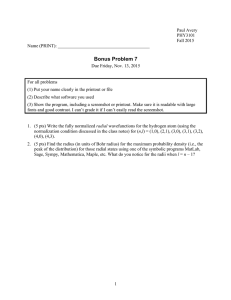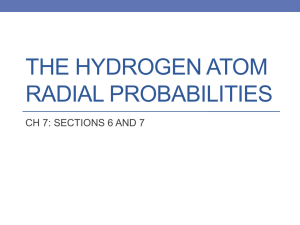Radial Vibrations in Short, Hollow Cylinders of Barium Titanate
advertisement
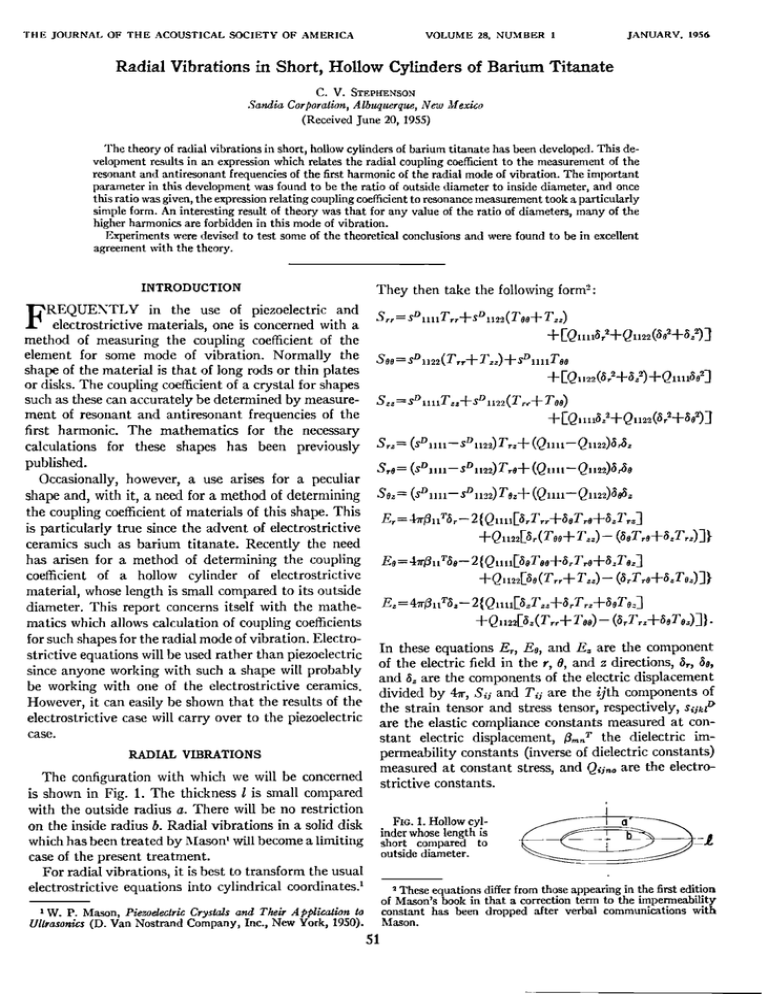
Tile
JOURNAL
OF THE
ACOUSTICAL
SOCIETY
OF AMERICA
VOLUME
28. NUMBER
I
JAN'UARV,
1956
Radial Vibrations in Short, Hollow Cylinders of Barium Titanate
C. V.
SandiaCorporation,
Albuquerque,
New Mexico
(ReceivedJune20, 1955)
The theoryof radial vibrationsin short,hollowcylindersof bariumtitanate hasbeendeveloped.This developmentresultsin an expression
whichrelatesthe radial couplingcoefficient
to the measurement
of the
resonantand antiresonantfrequencies
of the first harmonicof the radial modeof vibration.The important
parameterin this developmentwasfoundto be the ratio of outsidediameterto insidediameter,and once
thisratiowasgiven,the expression
relatingcoupling
coefficient
to resonance
measurement
tooka particularly
simpleform. An interestingresultof theorywasthat for any valueof the ratio of diameters,manyof the
higherharmonicsare forbiddenin this modeof vibration.
Experimentswere devisedto test someof the theoreticalconclusions
and were found to be in excellent
agreementwith the theory.
INTRODUCTION
They then take the followingformS:
REQUENTLVin the useof piezoelectric
and S,, = sø11nT,+sø1m(Too+T•)
e]ectrostrictivematerials,one is concernedwith a
q-[Qxxtl*?+Qll•(•oa+/iD]
method of measuringthe couplingcoefficientof the
elementfor somemode of vibration. Normally the Soo=sDn•( T..+ T•) + sZ)1111Too
shapeo[ the material is that of long rodsor thin plates
+ [Q,
or disks.The couplingcoefficientof a crystalfor shapes
suchas thesecanaccuratelybe determinedby measurement of resonantand antiresonantfrequencies
of the
first harmonic. The mathematics for the necessary
r.•+ (Ql11•-•,)•
calculationsfor these shapeshas been previously &•= (•,s%,)
published.
Occasionally,
however,a use arisesfor a peculiar
shapeand,with it, a needfor a methodof determining so=
the couplingcoefficient
of materialsof this shape.This
= 401*& - 2{
is particularlytrue sincethe adventof electrostrictive
ceranficssuch as barium titanate. Recently the need
has arisen for a method of determining the coupling
coefficientof a hollow cylinder of electrostrictive
material,whoselengthis smallcompared
to its outside
diameter.This report concerns
itself with the mathematicswhichallowscalculationof couplingcoefficients
forsuchshapes
fortheradialmodeof vibration.Electrostrictireequations
will beusedratherthanpiezoelectric In theseequationsE•, Eo, and E• are the component
of the electricfield in the r, 0, and z directions,$,, 8s,
sinceanyoneworkingwith sucha shapewill probably
and •, are the components
of the electricdisplacement
be workingwith one of the electrostrictive
ceramics. dividedby •, S•i andTo aretheijth components
of
However,it caneasilybe shownthat the resultsof the the straintensorand stresstensor,respectively,
electrostrictive
casewill carry over to the piezoelectric are the elasticcompliance
constantsmeasured
at concase.
stant electricdisplacement,
O•v the dielectric
RADIAL
permeability
constants
(inverse
ofdielectric
constants)
VIBRATIONS
measur• at constantstress,and Q•i•oare the electroThe configuration
with whichwe will be concerned strictlye constants.
is shownin Fig. 1. The thicknessI is smallcompared
with the outside radius a. There will be no restriction
on the inside radius b. Radial vibrations in a solid disk
FIO.
1.
Hollow
cyi'•_
__
•_
inderwhoselength•
shortcompared
to
which has beentreated by Mason' will becomea limiting
caseof the presenttreatment.
outside diameter.
For radial vibrations,it is best to transformthe usual
electrostrictive
equationsinto cylindricalcoordinatesJ • Theseequations
differfromthoseappearing
in thefirstedition
of Mason'sbook in that a correctionterm to the impermeabilit¾
l W. P. Mason, Piezoelectric
Crystalsand Their Applicationto
Ultrasorties
(D. Van NostrandCompany,Inc., New York, 1950).
51
constanthas been droppedafter verbal communications
with
Mason.
52
C.
V.
STEPHENSON
Insolving
theequations
ofm•tion,
itisalso
necessary
where15•0
is the reinanentelectricdisplacement
caused
to know the strains in terms of the mechanical dis-
by polarization and /t• the alternating component.
the alterplacementsin the r, O,and z directions.Denotingthese Solvingthe aboveequationssimultaneously,
hating componentof the stressand displacementare
displacements
by ur, uo,and u• the strainsare:
givenby the equations
T
Or
/ Yo• \
4•rfinr(1
S, = r O0
T / Yø•x S
r
os=
Oz
Ouo uo
Or
r
4•rfinv
1 OUr
where
r
and
+
2Qmd'øYø•E-
4•r•n v
(T.+T.)
--sem•/semt= v is the Poismn'sratb
1/semi= Yo• is Young'smodulusin which
OUr
$Dl122
SEl122
•
l Ouz
Sos= - --+
1
r O0
and
$DIIII
We will assume that the thickness is so small that the
$•1111m
changeof stressin the z directionis negligible.Since
the stressesare zero at the surface,we can set
Furthermore,sincewe shallconsider
only motionthat
is entirely radial, T•o= 0 and also u0= u•= 0. We will
considerthe casein which the field is appliedonly in
the •. direction so that/5,--$0=0.
1
•115•1111
The o•y remainingequation which is ne•ed is •e
force equation which becomesfor the describ•
conditions
OT.
The electrostrictive
equationsnowbecome:
QZll2dZz
0'
(T•--TOo)
•=
Since now
S,r = søm•T•,-1L
søn2Tooq-Q
m•
S•=--
Soo
=
Ez= 4•Onr•.-- 2Qm•. (T.+ Too).
In the case of electrostrictive
ceramics the electric
displacementmay be representedby
Soo=--
the equationof motionbecomes
--
'
1--a•kOr •
28
and
t
=o
r Or
= -•¾u,
for simpleharmonicmotion.
This isa Bessel's
equationof thefirstoMerwhichhas
24
22
the solution
/wr•
1•i
Yo•
16
14
12
IO
whereJlCr/v) andK•(•/v) are Besselhnctionsof •e
first and secondkind. The boundaryconditionsare •at
the stressT•,=0 when r=a and when r=b, a and b
being the outsideand insideradii.
4
C
4
8
io
Fro. :2.Plot of œu•½tion/(•or/•)
w•ch
re•n•nce
condition.
}
VIBRATIONS
OF
BaTi
CYLINDER
53
Insertingthe boundaryconditions
and solvingfor a and/5weget
X
• x¾i
a K'\¾/JL•'Jø\¾l-b Jx\•-/j
Qtt•.•0E,(1-l-a)
admittancel/Z= i/Ed=i<oQ/Ed. We neednowto find
an expression
for the surfacechargeQ.
Sincethe value of • at the surfaceis equal to the
surfacechargedensitywe canfind Q by performingthe
integration
This gives
.
(\1--½•/I
¾ø"
/ [,
:,-.=
Q=L dOJ•
•,rdr.
.¾..,
('
Evaluatingthis integraland makingthe substitution
•r/SVn(1-v) _l 4•r/snen
raw
[•,\ (l-a)(•or)]}
QmCzoYoEE,
where /5nne is the radially clampedimpermeability
constant,we have
Substitutingthesevalueswe find that
Q=
4•r/5•'11 a-/5•'n
(1 --o')
Qm½,oY% r oJ /•or\
-1 --/a-Jol--I
2r/•rn(1-,)[
c•
+/5-KoI--I/.
v
\v/
v
\*lJ
The next step is to obtain an expressionfor the electrical admittance.The admittanceis equal to the current into the elementdividedby the voltageacrossit.
But for simpleharmonicmotionthe currentis i= dQ/dt
=ja• where Q is the surfacecharge.This gives for
-J-J•'[IJI'KI(?)The radial couplingcoefficientcan be expressed
as
',,'/5•',,
(1--o')'
Using this and the two expressions
for the constants
and/5 we arrive at the formidableexpression
54
C.
V.
STEPHENSON
-j
.¾.-
b
xT/Jt;
-- (gJl\71jj
The resonantfrequencyoccurswhenthe admittance of the crystalradii a/b=A/B thereis oneand only
one value of the function which will have the two roots
becomes infinite or when
A andB. This meansthat if thisportionof the curveis
plotted carefully,one can find the two rootsA and B
which correspondto eachvalue of f(cor/,) and these
values of A and 33 may be plotted against the ratio
of the radii a/b. Figures3 and 4 showsuchplot. Thus
giventhe valuesof a and b the resonantfrequencyis
uniquelydetermined.
The otherpart of the curvein Fig. 2 corresponds
to
higherharmonics.
It is particularlyinteresting
to note
Thismeans
thatthefunction
corK(cot
•
(7)
1.9
cot
,.7
(?)
Fro.
runs(have
tworootsforanypossible
v•ue of thefunc-
tion.Onerootcorresponds
to A=•,a/v where
• is
th(resonantfrequent, and the otheris B=w•b/v.A
plo[ofthisfunction
isgivenin Fig.2.In thisplot,the
Poison ratio of bari•
titanatea=0.30 is a•umed.
The first U-shap• part of the •e
co•espondsto the
first ha•o•c.
It is notic• that for eve• value of
LC
f(•/v) there
aretwovalues
ofwr/vwhich
satisfy
this
value of f(•r/v). It is alsonoticedthat for any ratio
3.
Plot
of
A =to,a/, as a function of the ratio a/b.
16
c•/b
VIBRATIONS
OF
BaTi
CYLINDER
55
I.½
2o.7
Fm.
4.
Plot
of
B
.5
B=w,.b/v as a function of the ratio a/b.
.4
.3
.2
.I
16
that whereas there is a first harmonic resonance for
any ratio of a/b, for any bigherharmonicthere are
5
6
O
only certain ratios of a to b which will allow this
harmonicto exist.Thusfor any crystalof this shape,
many of the higherharmonicsare forbidden.This of
coursedoesnot apply in the limiting caseof b=0 in
whichcaseall higherharmonics
are permissible.
There remainsthe problemof determiningwhat
Fro. 5. Plot of the constantC whichoccursin the equation
k•/(l-k 2)=C(hf/f•) as a functionof the ratio a/b
ßß
happensat antiresonance.This occurswhen the ex-
pression
in brackets
in theadmittance
equationreduces
to zero. The frequencyseparationbetweenresonance
and antiresonance
canbe obtainedby developing
the
Besselfunctionsin Taylor seriesaboutthe rootsA and
B. This gives
Af
•-(l--a)
2[Ko(A)Jo(B)-Ko(B)Jo(A)]--[-
=Jo(A)-AJ•(A)--+...
abouttherootB. Alsowehavecoa/,=A+A (/xf/fr) and
cob/v=B+B(/xf/f,). Insertingthesevaluesinto the
bracketexpression,
wegetto a firstapproximation
the
secondformidableexpression
fr
AB
1
af
wheref, isresonant
frequency.
Similarexpressions
can
bederived
forJo(cob/v),
Ko(cob/,),
Jz(cob/v)
andK•
(7)
x0T
wa
)
Jo
a/
= K•(A )-k AKo(A)--- K•(A )---k . . .
EK•(B)Ji(A)-K•(A)J•(B)]
1
+(1-o•)(•[K•(B)Jo(A)--Ko(A)Jt(B)]+-[Ko(B)J•(A
A
f½
ka
l+v
56
C.
V.
STEPHENSON
ments were available
which had had holes cut in their
center. These elements were 0.125 in. thick and had an
,-EXPERIMENT
outside diameter of 1.047 in. The hole diameters were
cot -•
0.126 in., 0.367 in., and 0.492 in. Unfortunatelyno
resonance measurements were made on these elements
beforethe holeswere cut. However, severalelements
of the samebatchwereavailablefor measurements,
and
these elementshad radial couplingcoefficientsof
0.264-0.01.Using the resultsof the precedingsection,
FIO. 6. Plot of the ratio of the resonantfrequencyof a hollow
coefficients
of the threetestsamples
cylinderto the resonantfrequencyof a soliddisk as a functionof theradialcoupling
the ratio b/a.
were0.25, 0.26, and 0.26.
.G
If the inner and outer radii and the Poisson's ratio is
known this equationcan be put into the form
1--k 2
f•
where C is a constant. For barium titanate the value of
this constant has been calculated for various ratios of
a/b and is plottedin Fig. 5.
The preceding
sectionalsopredictsthat, whencomparedwith the resonant
frequency
of the soliddisk,
the resonantfrequency
of an elementwith a holein
the middle shoulddecreasewith increasinghole diameterif the outsidediameteris kept constant.The
ratioof theresonantfrequencyof a ringto the resonant
frequency
of thesoliddiskis plottedagainsttheratio
a/b asthesolidlinein Fig.6. Theratiosof theresonant
frequencies
of the threeexperimental
elements
to the
average
oftheresonant
frequencies
ofothercrystals
of
EXPERIMENTAL
points.The
The resultsof the preceding
sectionwerecheckedby the samebatchareplottedasexperimental
is withinexperimental
error.
the followingexperiments.
Three barium titanate ele- agreement
THE JOURNAL
OF THE ACOUSTICAL
SOCIETY
OF AMERICA
VOLUME
:18. NUMBER
I
JANUARY.
1956
Propagation
of ElasticWavesin CylindricalShells,Includingthe Effectsof
TransverseShear and Rotatory Inertia*
P.M.
NAOttDI AN• R. M. COOPER
University
of Micldgan,Ann Arbor,Hichigar•
(ReceivedAugust24, 1955)
Twosystems
of equations
of motion,
designated
as (I) and(II), forthinrusticcylindrical
shells
are
derivedwhichincludethe effectsof both trmasverse
sheardeformationand rotatoryinertia.The cbaxacter
of the twosystems
of equations
is suchthat, upontheneglectoftransverse
sheardeformation
androtatory
inertia,Eqs.(I) willreduce
to those
'known
asLove's
firstapproximation,
while(II), whichenjoys
a considerablemathematical
simplicity
ascompared
to (1), will correspond
to thosegivenby Donnell.Bothsystems
ofEqs.(I) and(II) areemployed
in a studyforpropagation
ofaxisymmetric
waves
in aninfinitecylindrical
shell.Theagreement
between
thepredictions
of thetwosystems
of equations,
in all modes
of motion,for
phasevelocities
of propagated
wavesin the complete
rangeof wavelengths
is foundto beexcellent.
The
results,
withreference
to thenatureof themodes
of motionaccording
to both(I) and(II), arefretherexaminedandthe relativemeritof the presentpaperto the workof otherauthorsis discussed.
INTRODUCTION
N a recent
paper
t dealing
withthegeneral
theory
of
thin isotropicelastic shells (where the effectsof
transverse
normalstress,transverse
sheardeformation,
and rotatoryinertiaare alsodiscussed),
a setof stressdisplacementrelations is deduced which is entirely
consistent
with the assumptions
for the stresses
and
displacements
in a thin shell;theseresultswereobtained by meansof a variationaltheoremdue to
E. Reissner2
In the sequel,usingthe basicequations
of
reference1, two systemsof equationsof motionfor
elasticcylindricalshellswill be considered.
Thesesystemsof equations
of motion,whichincludethe effects
* The resultspresented
in th/spaperwereobtainedin the course
of researchsponsoredby the Office of Naval Researchunder of both transverse shear deformation and rotatory
Contract Nonr-1224(01), NR 064-408 with the University of inertia,will be designated
as Eqs. (I) and (II); Eqs.
Michigan.
• P.M. Blaghdi, ONR Project NR-064-48, Contract Nonr1224(01),Engineering
Research
Institute,Universityof Michigan,
Tech. Repts. No. 1 and 2 (January and March, 1955) (to be
published).
(II) enjoysomemathematicalsimplicityas compared
to (I) and will be referredto as an "approximate"
Eric Reissner,
J. Math. Phys.29, 90-95 (1950).
